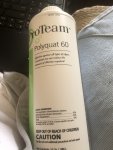I am closing and added 1 quart of Polyquat 60 to my 16x32 inground pool. A couple of days later I checked the PH and it has gone off the scale to the high side. I added 14 drops of R5 acid demand to get it back to about 7.8. Nothing else has changed and the FC is 7.5.
I have searched the forum here and see a lot of people asking this same question but the answer is alway "NO" the Polyquat will not increase PH. If this is true then why have many of us experienced this?
I am out of Muriatic acid and wonder if it is really necessary to pour over a gallon of it into the water. I'm attaching the label of the PolyQ, any help would be appreciated.
I have searched the forum here and see a lot of people asking this same question but the answer is alway "NO" the Polyquat will not increase PH. If this is true then why have many of us experienced this?
I am out of Muriatic acid and wonder if it is really necessary to pour over a gallon of it into the water. I'm attaching the label of the PolyQ, any help would be appreciated.


